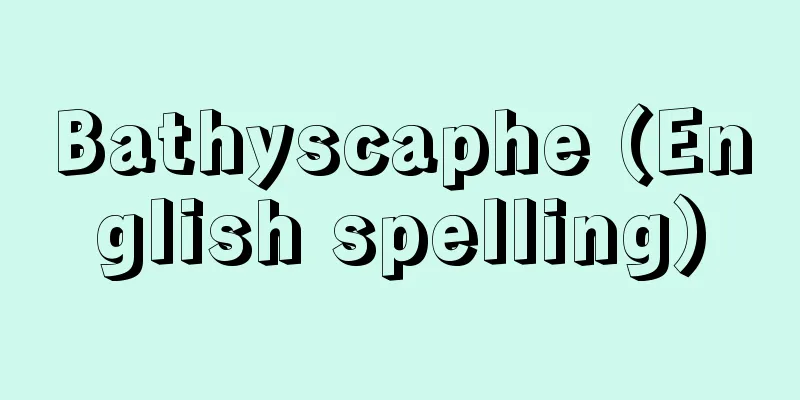Bathyscaphe (English spelling)

|
This manned submersible for deep-sea research was invented and built by Swiss physicist A. Piccard and his son J. Piccard. The principle is the same as that of an airship or balloon, where the boat balances its own weight with buoyancy in the deep sea. The boat is loaded with gasoline to obtain buoyancy, and a large amount of 0.8 mm diameter iron shot as weights. The boat descends by filling the air tank with seawater, and when surfacing, an appropriate amount of shot is dumped into the sea. The spherical observation chamber is made of 9 cm thick special steel that can withstand the water pressure of 16,000 meters deep, or 1,600 atmospheres. The first bathyscaphe, FNRS II, was built in 1948 with the support of the Belgian Foundation for Scientific Research (FNRS). Its name was derived from A. Piccard's stratospheric exploration balloon FNRS. FNRS III was then built based on FNRS II. In 1959, the US Navy purchased Trieste I from Piccard, and in 1960, J. Piccard and Walsh set a world record of 10,916 meters in the Mariana Trench. In 1963, the US Navy used an improved version of Trieste II to successfully photograph the wrecked US nuclear submarine Thresher. In addition, French Navy bathyscaphes cooperated with Japan to survey the Japan Trench and the Kuril Trench several times, and in 1961, Archimède recorded a depth of 9,592 meters in the Kuril Trench. The Alcimede was a new boat completed in the same year, with a submerged displacement of 209 tons and a length of 22 meters. The bathyscaphe principle has since been used in manned deep-sea research submersibles around the world. Japan's Shinkai 2000 also uses this principle, and instead of gasoline, it uses hollow glass beads of about 100 micrometers in diameter and hardened with epoxy resin, with a specific gravity of about 0.55, for buoyancy. [Masao Hanzawa] ©Toshihisa Watanabe "> Bathyscaphe Structure (Alchimede) Source: Shogakukan Encyclopedia Nipponica About Encyclopedia Nipponica Information | Legend |
|
スイスの物理学者A・ピカールが息子のJ・ピカールと考案、製作した深海調査用の有人潜水艇。原理は飛行船や気球と同じで、深海で自重と浮力をつり合わせる。艇には、浮力を得るためのガソリンと、おもりとして直径0.8ミリメートルの鉄製散弾を多量に積んでいる。下降は空気タンクに海水を入れて行い、浮上には適量の散弾を海中に捨てる。球形の観測室は、深度1万6000メートルの水圧、1600気圧に耐える厚さ9センチメートルの特殊鋼でつくられている。 最初のバチスカーフFNRS(エフエヌエルエス)2号は、ベルギー科学研究財団FNRSの援助によって1948年に製作された。名称はA・ピカールの成層圏探検用気球FNRS号を継承している。続いて2号をもとにしてFNRS3号が製作された。1959年、アメリカ海軍はピカールからトリエステTriesteⅠ号を購入、1960年にJ・ピカールとウォルシュが乗り組み、マリアナ海溝で潜水の世界記録、1万0916メートルを樹立した。1963年アメリカ海軍は、改良型のトリエステⅡ号で、遭難したアメリカ原子力潜水艦スレッシャー号の写真撮影に成功している。また、フランス海軍のバチスカーフは日本と協力して数次にわたり日本海溝、千島海溝を調査し、1961年にはアルシメードArchimède号が千島海溝で9592メートルの深度を記録した。アルシメード号は同年に完成した新造艇で、水中排水量209トン、長さ22メートルである。 バチスカーフの原理はそれ以後の世界の有人深海調査用潜水艇に活用されている。日本の「しんかい2000」もこの原理で、浮力用には、ガソリンにかえて、エポキシ樹脂で固めた100マイクロメートル前後の中空のガラス玉で、比重約0.55のものが用いられている。 [半澤正男] ©渡部利久"> バチスカーフの構造(アルシメード号) 出典 小学館 日本大百科全書(ニッポニカ)日本大百科全書(ニッポニカ)について 情報 | 凡例 |
Recommend
Washuzan ruins
Located at Washuyama Kusumihana in Ohata, Kurashik...
Todus mexicanus (English spelling)
…[Naoya Abe]. … *Some of the terminology that men...
Eshiki Mairi - Eshiki Mairi
...Although it is also used simply to mean a Budd...
Aya River
A general term for the Ayakita River and Ayanan Ri...
Kisokuri - Kisokuri
…In sharp opposition to this is the theory of min...
Cordyceps tricentri
…[Tsubaki Keisuke]. . . *Some of the terminology ...
Sovetskaya literatura (English spelling)
...The term "Russian/Soviet literature"...
loudspeaker
…It is also called a loudspeaker. In English, it ...
ABC
〘 noun 〙 (meaning a blood-related mother) A biolog...
educational measurement
…In addition, educational evaluation is generally...
Uniformitarianism
A theory or view of nature that holds that the va...
Juji Ishii
Year of death: January 30, 1914 Year of birth: 186...
Kawaramono - Kawaramono
A derogatory term for actors, theater people, str...
horǎ (English spelling) hora
...Colindǎ, which is sung from Christmas to New Y...
Natasho [village] - Natasho
A village in Oniyuu County, in the southwestern ti...









